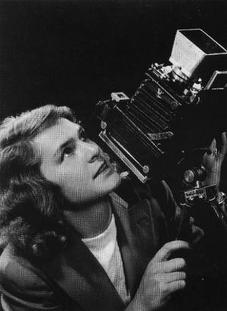 by Yoon Joung Lee Margaret Bourke-White, the first foreign photographer who took pictures of Soviet society and the first female war correspondent, was born in 1904, in the Bronx, New York. Her father, Joseph White, was a Polish-Jewish inventor and an engineer. Her loving and caring mother, Minnie Bourke was an Irish-English woman. In the early years of her life, Bourke-White along with her two siblings was educated by their mother who strived to raise her kids in a very protective environment, away from such artificial products as junk foods and tabloid papers. Despite her interest in photography, Bourke-White began to study herpetology at Columbia University in 1922 and did not develop her interest in photography at the time. Later at Cornell University, she met Clarence White who then was leading the pictorial school of photography at Cornell University and was able to study photography under him. While she was in Cornell, she had married an engineering graduate student named Everett Chapman in 1924, but they ended up divorcing after two years of the marriage. Upon her graduation from Cornell University in 1927, she decided to move to Cleveland, Ohio to open her own photography studio specializing in architectural and industrial photography. In 1929, she took the position as an associate editor and a staff photographer at the new Fortune magazine. While with Fortune, she had visited the Soviet Union several times as the first permitted photographer to take photographs of the Soviet Industry and also published Eyes on Russia in 1931. She had held the position until 1935. In 1936, she got an offer from Henry Luce at Life magazine and became the first female photojournalist. Her photograph of the Fort Peck Dam was on the cover page of the first edition of Life magazine. During the mid-1930s, she had toured around South America with a novelist, Erskine Caldwell and had taken pictures for their book “You Have Seen Their Faces” that documented the reality of poor tenant farmers’ living conditions. The book was published in 1937. In 1939, Bourke-White remarried Caldwell. When the German Army attacked the Soviet Union in 1941, the couple were the only foreign journalists at that time. They had sent a series of spectacular photographs of combat zones to Life magazine. They returned to the States in 1942 and published the book “Say, Is This the U.S.A.” portraying the life in the U.S. right before World War II. However, shortly after returning home in 1942, the couple divorced. After their split, she became the first female war correspondent working for the U.S. Army Air Force in North Africa, working for the U.S. Army in Italy, and later working in Germany during the World War II. She was also one of the first photographers to be allowed to enter and take pictures of death camps. In 1946 after the war, she was sent to Pakistan and India by Life to cover the emerging of these countries. There, Bourke-White became renowned in both India and Pakistan by her photographs of Mahatma Gandhi, especially by one of her most famous photographs, Gandhi at His Spinning Wheel. Her last photograph of Gandhi was taken only a few hours before he was assassinated. From 1949 to 1956, she had photographed in South Africa and the Korean War. In 1949, she stayed in South Africa for five months to record the brutality of apartheid. In 1952, she went to Korea to photograph the family sorrows and tragedies that happened during the war. Shortly after returning home from Korea in 1956, she found out that she had Parkinson’s Disease. In 1958, she received the first operation for easing the effects of Parkinson’s and it was successfully done. Although her condition restrained her from working for Life magazine as a photographer, she continued to work as a writer. Along with Alfred Eisenstaedt, Bourke-White’s friend and also a photographer, she covered her own story of surgery she had undergone in Life magazine and the story became very famous. In 1961, she had to receive the second operations because of the reappearance of the Parkinson’s symptoms. Although the surgery was successfully operated, it brought her a speech difficulty. During this time, she started to write her autobiography “Portrait of Myself,” and was able to complete it before she died in 1971 by a complication caused by Parkinson’s. Margaret Bourke-White’s contribution to the field of Photography is unspeakably huge. Being in various battlefields around the world and taking photographs in dangers are difficult even for men. As a woman, her life was full of adventure. However, she successfully completed her work and became one of the most important photographers of the twentieth century. |
Archives
July 2017
Categories
All
|
 RSS Feed
RSS Feed